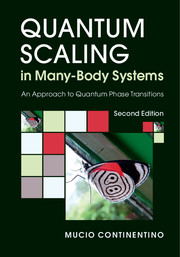Book contents
- Frontmatter
- Dedication
- Contents
- Preface
- 1 Scaling Theory of Quantum Critical Phenomena
- 2 Landau and Gaussian Theories
- 3 Real Space Renormalisation Group Approach
- 4 Renormalisation Group: the ∊-Expansion
- 5 Quantum Phase Transitions
- 6 Heavy Fermions
- 7 A Microscopic Model for Heavy Fermions
- 8 Metal and Superfluid–Insulator Transitions
- 9 Density-Driven Metal–Insulator Transitions
- 10 Mott Transitions
- 11 The Non-Linear Sigma Model
- 12 Superconductor Quantum Critical Points
- 13 Topological Quantum Phase Transitions
- 14 Fluctuation-Induced Quantum Phase Transitions
- 15 Scaling Theory of First-Order Quantum Phase Transitions
- Appendix
- References
- Index
1 - Scaling Theory of Quantum Critical Phenomena
Published online by Cambridge University Press: 04 May 2017
- Frontmatter
- Dedication
- Contents
- Preface
- 1 Scaling Theory of Quantum Critical Phenomena
- 2 Landau and Gaussian Theories
- 3 Real Space Renormalisation Group Approach
- 4 Renormalisation Group: the ∊-Expansion
- 5 Quantum Phase Transitions
- 6 Heavy Fermions
- 7 A Microscopic Model for Heavy Fermions
- 8 Metal and Superfluid–Insulator Transitions
- 9 Density-Driven Metal–Insulator Transitions
- 10 Mott Transitions
- 11 The Non-Linear Sigma Model
- 12 Superconductor Quantum Critical Points
- 13 Topological Quantum Phase Transitions
- 14 Fluctuation-Induced Quantum Phase Transitions
- 15 Scaling Theory of First-Order Quantum Phase Transitions
- Appendix
- References
- Index
Summary
Quantum Phase Transitions
Quantum phase transitions, in contrast to temperature-driven critical phenomena, occur due to a competition between different parameters describing the basic interactions of the system. Their specific feature is the quantum character of the critical fluctuations. This implies, through the uncertainty principle, that energy fluctuations and time are coupled. Then at zero temperature time plays a crucial and fundamental role, the static properties being entangled with the dynamics (Continentino, 1994a; Sondhi et al., 1997; Sachdev, 1999). In this book we are mainly interested in quantum phase transitions that occur in electronic many-body systems and how scaling concepts can be useful to understand their properties close to these transitions (Continentino, 1994a). Even though a similar approach has been used in the case of interacting bosons (Fisher et al., 1989) the fermionic problem has its own idiosyncrasies and difficulties. For example, there is no natural order parameter associated with the localisation transition in the electronic case, while bosons at zero temperature are either localised or superfluid so that the superfluid order parameter can be used to distinguish between both phases.
If the results of the study of quantum phase transitions were restricted to zero temperature, this would be an interesting but purely academic area of research. What is really exciting about this subject is the effect of quantum critical points (QCP) in the finite temperature phase diagram of actual physical systems, even far away from the QCP (Freitas, 2015). As we will show, there is a special line in this phase diagram, the quantum critical trajectory, where the temperature dependence of the thermodynamic and transport properties is governed by the quantum critical exponents, i.e. those associated with the QCP. This and the observed crossover effects induced by temperature in the non-critical side of the phase diagram of a material with a QCP are sufficient to make the study of quantum phase transitions an inevitable subject.
We start this chapter by introducing the scaling theory of quantum critical phenomena, since scaling concepts are used throughout this book.
- Type
- Chapter
- Information
- Quantum Scaling in Many-Body SystemsAn Approach to Quantum Phase Transitions, pp. 1 - 24Publisher: Cambridge University PressPrint publication year: 2017



